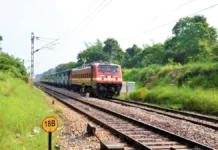NEW DELHI (Metro Rail News): The USBRL (Udhampur Srinagar Baramulla Rail Link) is a National project undertaken by the Indian Railways to construct a broad-gauge railway line through the Himalayas, intending to connect the Kashmir region with the rest of the country.
On December 15th, 2022, a significant milestone was achieved by executing the breakthrough of Escape Tunnel T-49 between the Sumber and Khari Stations on the Katra –Banihal section of the USBRL project.
The length of the escape tunnel is 12.895 km. This is the longest escape tunnel in India, and the line and level of the Tunnel are precisely achieved during the breakthrough of the Escape Tunnel. Shri S.P. Mahi, Chief administrative officer/USBRL, has achieved this breakthrough with his team of officials and staff.
It is a modified horseshoe shape tunnel connecting the Sumber Station yard on the Southside & Tunnel T-50 after crossing Bridge no.04 over Khoda Nallah on the North side, at Khoda village. The elevation of the South end at Sumberis is approx 1400.5 m and of the North end is 1558.84 m. The ruling gradient inside the Tunnel is 1 in 80. The boring was done from various faces from the South portal and north portal and through three Aditsi.e.Urnihal (323 m), HingniAdit (280m) & Kundan Adit (739m).
The Tunnel T-49 is a twin tube tunnel comprising the Main Tunnel (12.75 Kms.) & Escape Tunnel (12.895 Kms.) connected with 33 numbers of cross-passages at every cross-passage. The primary tunnel mining was completed, and the final lining works are progressing rapidly. The Tunnel is constructed as per International standards, in which provision of an Escape Tunnel has been made to facilitate rescue and restoration works in emergency cases. The Escape Tunnel passes through the Ramban formation of the Young Himalayas, and besides this, various distributaries/Nallahs of Chenab River like Khoda, Hingni, Kundan Nallah etc. Cross all along the alignment, making mining more of a highly challenging task.
Several Challenges were encountered during construction, such as shear zone, perched aquifer, highly jointed rock mass, rock problems of excessive squeezing and heavy water ingress. On the north end, the tunnel alignment passes through a fragile shear zone of carbonaceous phillite. The tunnel mining was challenging, and several surprises were met during tunnelling. Excessive deformations were recorded during tunnelling at several locations between Kundan and Seeran, but these challenges were successfully tackled professionally. Also, a major cavity was encountered in the escape tunnel on 21.03.2021 at Ch. 12/538 near the north portal due to extremely poor rock mass; the strength of Rock mass was not more than 5 MPA and RQD (Rock quality designation) <10, with damp to wet Groundwater Conditions. The calculated RMR( rock mass rating ) is 18, GSI( geological strength index) is 26, and Basic RMR ( Rock Mass Rating ) is 16. The vertical overburden near the cavity location was 150 m. The size of the cavity was about 3 m long and 15 m high from the crown, continuous flow of mass was also witnessed, and tunnelling in E.T. ( Escape Tunnel) was subsequently suspended. The tunnel face was immediately stabilised, and the fate was sealed. A detailed investigation was carried out, and a detailed methodology was finalised to attend to the cavity. The work was successfully carried out by negotiating the cavity.
The Tunnel was constructed by the New Austrian Tunnelling Method (NATM), a modern technique of drill and blast processes. Although the boring work of the Tunnel started from both directions up to the hand-shaking point, the precision of both ends meeting at one point was flawless. This is the result of meticulous planning and precise execution of tunnelling work, the line and level of the Tunnel perfectly matched in both portions after the breakthrough.
The team of experienced engineers of Indian Railways successfully negotiated all challenges and achieved the major milestone of the breakthrough of the Escape tunnel. Moreover, during the construction activities of the Tunnel, more than 75% of workers from nearby villages were engaged in various construction activities, thereby ushering a positive change in the overall socio-economic landscape of the region.
It is worth mentioning that the T-49 Tunnel (12.75 km) from Sumber to Sheeran village in Khari Tehsil area of Ramban district of Jammu and Kashmir UT is the longest transportation tunnel in the country. It is noteworthy to mention that there are three other tunnels on this project, the length of which are close to that of Tunnel T-49 and details for these are as follows :
- Tunnel T48 = 10.20km(Breakthrough already achieved) between village Dharam- Sumber station
- Tunnel T15= 11.25 km between Sangaldhan – Basindhadar stations
- Pirpanjal Tunnel= 11.2km between Banihal – Qazigund stations






